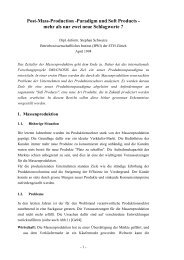The China Venture
The China Venture
The China Venture
Create successful ePaper yourself
Turn your PDF publications into a flip-book with our unique Google optimized e-Paper software.
Knowledge about the own position in a bargaining situation, about own strengths and<br />
weaknesses in negotiations and about the sources of bargaining power are a prerequisite to<br />
use the available “assets” to their fullest benefit.<br />
This section aims to help SMEs to understand their position in a “bargaining situation” in the<br />
Chinese context. First, the importance of every bargaining constellation such as for example<br />
SME – local banks in case of direct export or SME – Chinese Customer in case of a<br />
service/maintenance joint venture is rated. Second, interesting bargaining relations, i.e.<br />
situations where a SME is expected to have at least some bargaining power, are analysed.<br />
<strong>The</strong> following chart gives an overview of possible relations between a SME and its bargaining<br />
partners. Every intersection of rows and columns represents one possible bargaining situation.<br />
Depending on the SME’s intention and the chosen entry vehicle, the bargaining arenas differ<br />
widely in respect to bargaining partners and the relevance of the relation with them. While the<br />
relation with Chinese customers, for example, are highly relevant if the product is targeting<br />
the Chinese market, this relation does not exist in the case of “exploiting cost advantages” and<br />
producing for export only. According to the importance of a relation, intersections of rows<br />
and a columns are marked with X (low), XX (medium) or XXX (high). An intersection<br />
marked with a 0 denotes that in this constelation no significant relation exists, i.e. the two<br />
parties can act without influencing each other.<br />
116






